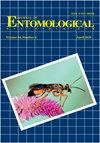Molecular Cloning and Expression Profiling of Minus-C Odorant Binding Proteins from Apocheima cinerarius (Lepidoptera: Geometridae)1
IF 0.7
4区 农林科学
Q4 ENTOMOLOGY
引用次数: 0
Abstract
Based on transcriptome data of adults and pupae, 3 Minus-C OBPs (odorant binding proteins) genes were cloned and analyzed in various tissues (including head, thorax, abdomen, legs of female and male adults, and wings of males) of Apocheima cinerarius Erschoff (Lepidoptera: Geometridae). Expression patterns were examined across the developmental stages of egg, larva (1st–5th instars), pupa (non-diapause and diapause), and adults. The qRT-PCR results revealed a significant up-regulation of OBP8 in 3rd and 4th larval instars, with the highest expression level observed in 4th-instar larvae. OBP14 exhibited higher expression levels in diapausing pupal and adult stages, with highest levels in the female adult. Conversely, OBP18 displayed highest expression in the non-diapausing pupae, while exhibiting extremely low expression levels among other stages. The tissue expression profile revealed a gradual increase in the expression of OBP14, with highest levels in the male legs, whereas the expression pattern of OBP18 exhibited an inverse trend with maximum expression observed in the male head (including antennae). OBP8 exhibited high expression levels in the abdomen of the female adult, while OBP14 showed high expression in the legs of the male adult. Additionally, OBP18 displayed high expression in the female head. These findings suggest the crucial role played by OBP genes in both olfactory and non-olfactory tissues of A. cinerarius. The results provide a fundamental basis for further investigation into the recognition of odorant binding in A. cinerarius.Apocheima cinerarius(鳞翅目:尺蠖科)Minus-C 气味剂结合蛋白的分子克隆和表达谱分析1
根据成虫和蛹的转录组数据,克隆并分析了Apocheima cinerarius Erschoff(鳞翅目:尺蠖科)不同组织(包括头部、胸部、腹部、雌成虫和雄成虫的腿部以及雄成虫的翅膀)中的3个Minus-C OBPs(气味结合蛋白)基因。对卵、幼虫(1-5龄)、蛹(非休眠期和休眠期)和成虫各发育阶段的表达模式进行了研究。qRT-PCR 结果显示,OBP8 在幼虫三龄期和四龄期有显著的上调,四龄幼虫的表达水平最高。OBP14 在蛹期和成虫期的表达水平较高,其中雌成虫的表达水平最高。相反,OBP18 在非滞育蛹中的表达量最高,而在其他阶段的表达量极低。组织表达谱显示,OBP14 的表达量逐渐增加,雄性腿部的表达量最高,而 OBP18 的表达模式呈反向趋势,雄性头部(包括触角)的表达量最高。OBP8 在雌性成虫腹部的表达水平较高,而 OBP14 在雄性成虫腿部的表达水平较高。此外,OBP18 在雌性头部也有高表达。这些研究结果表明,OBP基因在琥珀蟾蜍的嗅觉组织和非嗅觉组织中都起着至关重要的作用。这些结果为进一步研究食蚁兽对气味结合的识别提供了基本依据。
本文章由计算机程序翻译,如有差异,请以英文原文为准。
求助全文
约1分钟内获得全文
求助全文
来源期刊
CiteScore
1.20
自引率
11.10%
发文量
40
审稿时长
>12 weeks
期刊介绍:
The Journal of Entomological Science (ISSN 0749-8004) is a peer-reviewed, scholarly journal that is published quarterly (January, April, July, and October) under the auspices of the Georgia Entomological Society in concert with Allen Press (Lawrence, Kansas). Manuscripts deemed acceptable for publication in the Journal report original research with insects and related arthropods or literature reviews offering foundations to innovative directions in entomological research
文献相关原料
| 公司名称 | 产品信息 | 采购帮参考价格 |
|---|

 求助内容:
求助内容: 应助结果提醒方式:
应助结果提醒方式:


